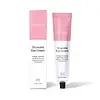What's inside
What's inside
 Key Ingredients
Key Ingredients

 Benefits
Benefits

 Concerns
Concerns

 Ingredients Side-by-side
Ingredients Side-by-side

Water
Skin ConditioningCoco-Caprylate
EmollientUrea
BufferingGlyceryl Stearate
EmollientBacillus Ferment
Skin ConditioningCetyl Alcohol
EmollientDalea Spinosa Seed Oil
MaskingTocopherol
AntioxidantPolyglyceryl-6 Stearate
EmollientStearic Acid
CleansingSimmondsia Chinensis Seed Oil
EmollientOryza Sativa Bran Oil
EmollientHexylresorcinol
AntimicrobialGlycerin
HumectantSodium Anisate
AntimicrobialSodium Levulinate
Skin ConditioningSodium Ascorbyl Phosphate
AntioxidantLactic Acid
BufferingGlyceryl Caprylate
EmollientPolyglyceryl-6 Behenate
Emulsion StabilisingGellan Gum
Ferulic Acid
AntimicrobialGlycyrrhiza Glabra Root Extract
BleachingSodium Phytate
Chamomilla Recutita Flower Extract
MaskingXanthan Gum
EmulsifyingCitric Acid
BufferingPotassium Sorbate
PreservativeWater, Coco-Caprylate, Urea, Glyceryl Stearate, Bacillus Ferment, Cetyl Alcohol, Dalea Spinosa Seed Oil, Tocopherol, Polyglyceryl-6 Stearate, Stearic Acid, Simmondsia Chinensis Seed Oil, Oryza Sativa Bran Oil, Hexylresorcinol, Glycerin, Sodium Anisate, Sodium Levulinate, Sodium Ascorbyl Phosphate, Lactic Acid, Glyceryl Caprylate, Polyglyceryl-6 Behenate, Gellan Gum, Ferulic Acid, Glycyrrhiza Glabra Root Extract, Sodium Phytate, Chamomilla Recutita Flower Extract, Xanthan Gum, Citric Acid, Potassium Sorbate
Water
Skin ConditioningDicaprylyl Carbonate
EmollientButyrospermum Parkii Butter
Skin ConditioningCetearyl Alcohol
EmollientGlycerin
HumectantSqualane
EmollientGlyceryl Stearate
EmollientAvena Sativa Bran Extract
AbrasiveCitrus Aurantium Dulcis Peel Extract
Emulsion StabilisingMoringa Oleifera Seed Oil
EmollientOpuntia Ficus-Indica Seed Oil
EmollientLycium Barbarum Callus Culture Extract
Skin ConditioningGardenia Jasminoides Fruit Extract
Cosmetic ColorantSodium Stearoyl Glutamate
CleansingCarbomer
Emulsion StabilisingCetearyl Glucoside
EmulsifyingIsomalt
HumectantSodium Benzoate
MaskingTetrahexyldecyl Ascorbate
AntioxidantTocopheryl Acetate
AntioxidantTetrasodium Glutamate Diacetate
Betaine
HumectantCeramide NP
Skin ConditioningPhospholipids
Skin ConditioningSodium Hyaluronate
HumectantMaltodextrin
AbsorbentSodium Hydroxide
BufferingPhenoxyethanol
PreservativeGlucose
HumectantLecithin
EmollientTocopherol
AntioxidantSodium Glycolate
BufferingSodium Formate
BufferingEthylhexylglycerin
Skin ConditioningCitric Acid
BufferingWater, Dicaprylyl Carbonate, Butyrospermum Parkii Butter, Cetearyl Alcohol, Glycerin, Squalane, Glyceryl Stearate, Avena Sativa Bran Extract, Citrus Aurantium Dulcis Peel Extract, Moringa Oleifera Seed Oil, Opuntia Ficus-Indica Seed Oil, Lycium Barbarum Callus Culture Extract, Gardenia Jasminoides Fruit Extract, Sodium Stearoyl Glutamate, Carbomer, Cetearyl Glucoside, Isomalt, Sodium Benzoate, Tetrahexyldecyl Ascorbate, Tocopheryl Acetate, Tetrasodium Glutamate Diacetate, Betaine, Ceramide NP, Phospholipids, Sodium Hyaluronate, Maltodextrin, Sodium Hydroxide, Phenoxyethanol, Glucose, Lecithin, Tocopherol, Sodium Glycolate, Sodium Formate, Ethylhexylglycerin, Citric Acid
 Reviews
Reviews

Ingredients Explained
These ingredients are found in both products.
Ingredients higher up in an ingredient list are typically present in a larger amount.
Citric Acid is an alpha hydroxy acid (AHA) naturally found in citrus fruits like oranges, lemons, and limes.
Like other AHAs, citric acid can exfoliate skin by breaking down the bonds that hold dead skin cells together. This helps reveal smoother and brighter skin underneath.
However, this exfoliating effect only happens at high concentrations (20%) which can be hard to find in cosmetic products.
Due to this, citric acid is usually included in small amounts as a pH adjuster. This helps keep products slightly more acidic and compatible with skin's natural pH.
In skincare formulas, citric acid can:
While it can provide some skin benefits, research shows lactic acid and glycolic acid are generally more effective and less irritating exfoliants.
Most citric acid used in skincare today is made by fermenting sugars (usually from molasses). This synthetic version is identical to the natural citrus form but easier to stabilize and use in formulations.
Read more about some other popular AHA's here:
Learn more about Citric AcidGlycerin is already naturally found in your skin. It helps moisturize and protect your skin.
A study from 2016 found glycerin to be more effective as a humectant than AHAs and hyaluronic acid.
As a humectant, it helps the skin stay hydrated by pulling moisture to your skin. The low molecular weight of glycerin allows it to pull moisture into the deeper layers of your skin.
Hydrated skin improves your skin barrier; Your skin barrier helps protect against irritants and bacteria.
Glycerin has also been found to have antimicrobial and antiviral properties. Due to these properties, glycerin is often used in wound and burn treatments.
In cosmetics, glycerin is usually derived from plants such as soybean or palm. However, it can also be sourced from animals, such as tallow or animal fat.
This ingredient is organic, colorless, odorless, and non-toxic.
Glycerin is the name for this ingredient in American English. British English uses Glycerol/Glycerine.
Learn more about GlycerinGlyceryl Stearate is a mix of glycerin and stearic acid.
It is used to stabilize the mixing of water and oil ingredients. By preventing these ingredients from separating, it can help elongate shelf life. It can also help thicken the product's texture.
As an emollient, it helps soften skin and supports barrier-replenishing ingredients.
In cosmetics, Glyceryl Stearate is often made from vegetable oils or synthetically produced.
This ingredient may not be fungal-acne safe
Fun fact: The human body also creates Glyceryl Stearate naturally.
Learn more about Glyceryl StearateTocopherol (also known as Vitamin E) is a common antioxidant used to help protect the skin from free-radicals and strengthen the skin barrier. It's also fat soluble - this means our skin is great at absorbing it.
Vitamin E also helps keep your natural skin lipids healthy. Your lipid skin barrier naturally consists of lipids, ceramides, and fatty acids. Vitamin E offers extra protection for your skin’s lipid barrier, keeping your skin healthy and nourished.
Another benefit is a bit of UV protection. Vitamin E helps reduce the damage caused by UVB rays. (It should not replace your sunscreen). Combining it with Vitamin C can decrease sunburned cells and hyperpigmentation after UV exposure.
You might have noticed Vitamin E + C often paired together. This is because it is great at stabilizing Vitamin C. Using the two together helps increase the effectiveness of both ingredients.
There are often claims that Vitamin E can reduce/prevent scarring, but these claims haven't been confirmed by scientific research.
Learn more about TocopherolWater. It's the most common cosmetic ingredient of all. You'll usually see it at the top of ingredient lists, meaning that it makes up the largest part of the product.
So why is it so popular? Water most often acts as a solvent - this means that it helps dissolve other ingredients into the formulation.
You'll also recognize water as that liquid we all need to stay alive. If you see this, drink a glass of water. Stay hydrated!
Learn more about Water